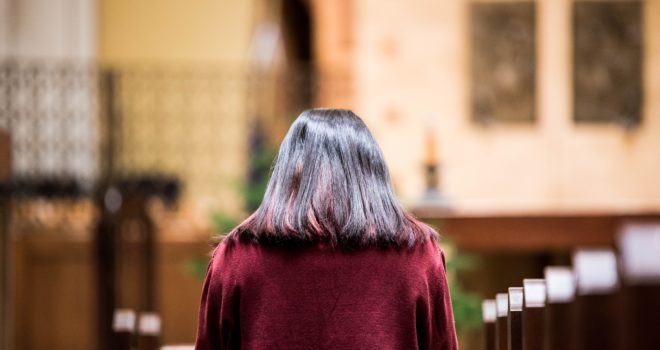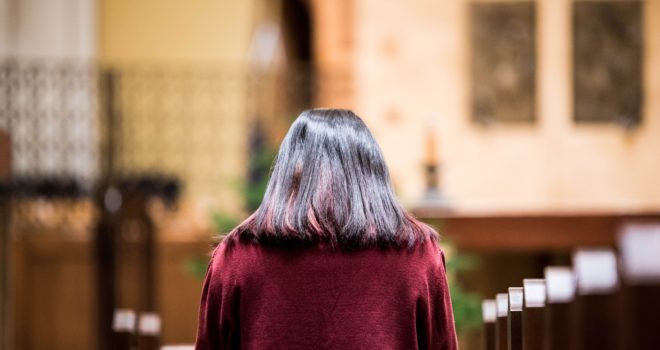Two major questions beginning with the word “when” occur toward the end of Matthew’s Gospel. One deals with “when” the end time will occur and the coming of Jesus will take place (Matt. 24:3). The other arises in the description Jesus makes of the final judgment (Matt. 25:31–46), “when the Son of Man comes in His glory, and all the angels with Him,” seated on His royal throne, with all the nations assembled before Him.
My soul thirsts for God,
for the living God.
When shall I come and
behold the face of God?
—Ps. 42:2
The Son of Man will separate them into two groups as a shepherd separates sheep from goats. Those inheriting the kingdom (the sheep), separated on the right, are the ones who recognized the Lord in the hungry and thirsty, the stranger and the naked, the sick and imprisoned; those not inheriting the kingdom (the goats), separated on the left, are the ones who did not recognize Jesus in those same people.
And the question asked by both those on the right and those on the left is the same question: “Lord, when was it that we saw You?” When Will the World End? The first “when” question in chapter 24 of Matthew’s Gospel finds
a resolution of sorts in the answer to the “when” question of chapter 25.
In chapter 24, Jesus talks about signs of the end time and “early stages of the birth pangs” of that end time. But He clearly avoids indicating any exact time. “But about that day and hour no one knows, neither the angels of heaven, nor the Son, but only the Father” (Matt. 24:36).
So do not be afraid; you are of more
value than many sparrows.
—Matt. 10:31After the End—the Judgment
Chapter 25 of Matthew’s Gospel provides a moral inventory for the followers of Jesus to determine whether he or she is prepared for that end time, with the Parable of the Ten Bridesmaids with their lamps going out to welcome the groom, five foolish and five wise; with the Parable of the Silver Pieces and how well the servants handled funds
entrusted to them; and finally the Last Judgment scene, where the Son of Man comes in His glory to render judgment. And the focus of the judgment scene of Matt. 25:31–46 is on how we’ve acted in the “here and now” of this life to assist those most in need in our midst. In doing good for the needy in the here and now, we come to the rescue of Jesus Christ Himself.
In Matthew’s Gospel, Jesus is telling us not to focus so much on the “when” of the Lord’s coming at the end time, but the “when” of the Lord’s coming, day to day, in our midst. If we recognize Jesus now in the hungry and thirsty, the stranger and the naked, the sick and the imprisoned, Jesus will recognize us on Judgment Day as the ones inheriting His kingdom. Our eternal happiness hinges on our moral and spiritual capacity to recognize Him and serve Him where He is in this world, in the time frame in which we are on earth.
Meeting the Lord
St. Teresa of Calcutta and the Missionaries of Charity, the community that she founded, are known worldwide for their aid to the poor and the outcasts of the world. They often are found where others will not go. What gives them the strength to minister in such harsh situations? The secret, Mother Teresa would tell an inquirer, was in how the community began its day—in prayer before Jesus present in the Most Blessed Sacrament. It was union with that Lord of the Eucharist that sustained her in her love of God and neighbor. Contemplating Jesus in the Holy Eucharist enabled her to see and serve Him in the thousands of needy people she met.
Pope John Paul II in his encyclical on the Eucharist said that “to contemplate Christ involves being able to recognize Him wherever He manifests Himself, in His many forms of presence, but above all in the living sacrament of His body and blood.”10 The Holy Father noted that not only does the Church draw its very life from Christ in the Eucharist as we are fed by the Lord, but it is also through the Eucharist that we are enlightened.
We can conclude that through the Eucharist we are “enlightened” to discover Christ in those around us crying out for help. And the Eucharist gives us the wisdom and strength to go one step further—to give concrete and constructive help to those in need. The answer to both of the “when” questions at the beginning of this chapter might be best stated as: when we discover the Lord of the Eucharist, we are able to put these “when” questions into the proper perspective. It is the Lord of the Eucharist Whose coming in the present overshadows the question of when the Lord will come at the end of time. Totally absorbed with the Lord’s present coming in the Eucharist, we are not anxious about the timing of the Lord’s future coming at the end of time. The Lord of the Eucharist helps us to be enlightened to recognize His presence in the people around us in our everyday lives who are in need of our help, care, and concern; and the Lord of the Eucharist gives us the wisdom and strength to address their needs in the most fitting ways possible.
We might want to avail ourselves of opportunities for Adoration of the Blessed Sacrament to allow the Holy Eucharist to nourish us, in the best ways, and give us strength to reach out and help those most in need in our midst. Could we support taking time out for intimate conversation with God—in this special, unique way—in
the course of the day, to bring our prayer, “When, Lord?” to the God Who awaits us? I think of the hundreds of people who pray daily before the Lord in special adoration chapels consecrated for this purpose in churches throughout our diocese and throughout the world, some of them providing opportunities for Eucharistic Adoration twenty-four hours a day.
The above article is excerpted from Prayers of Desperation, available now from Sophia Institute Press.
Photo by Gianna Bonello on Unsplash













